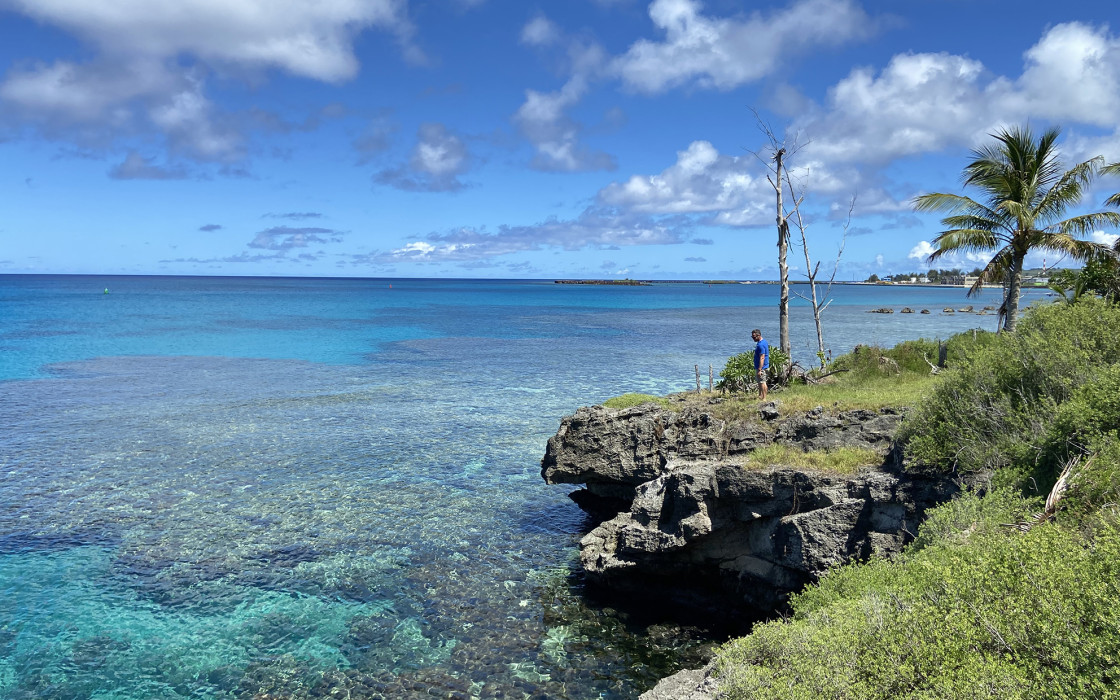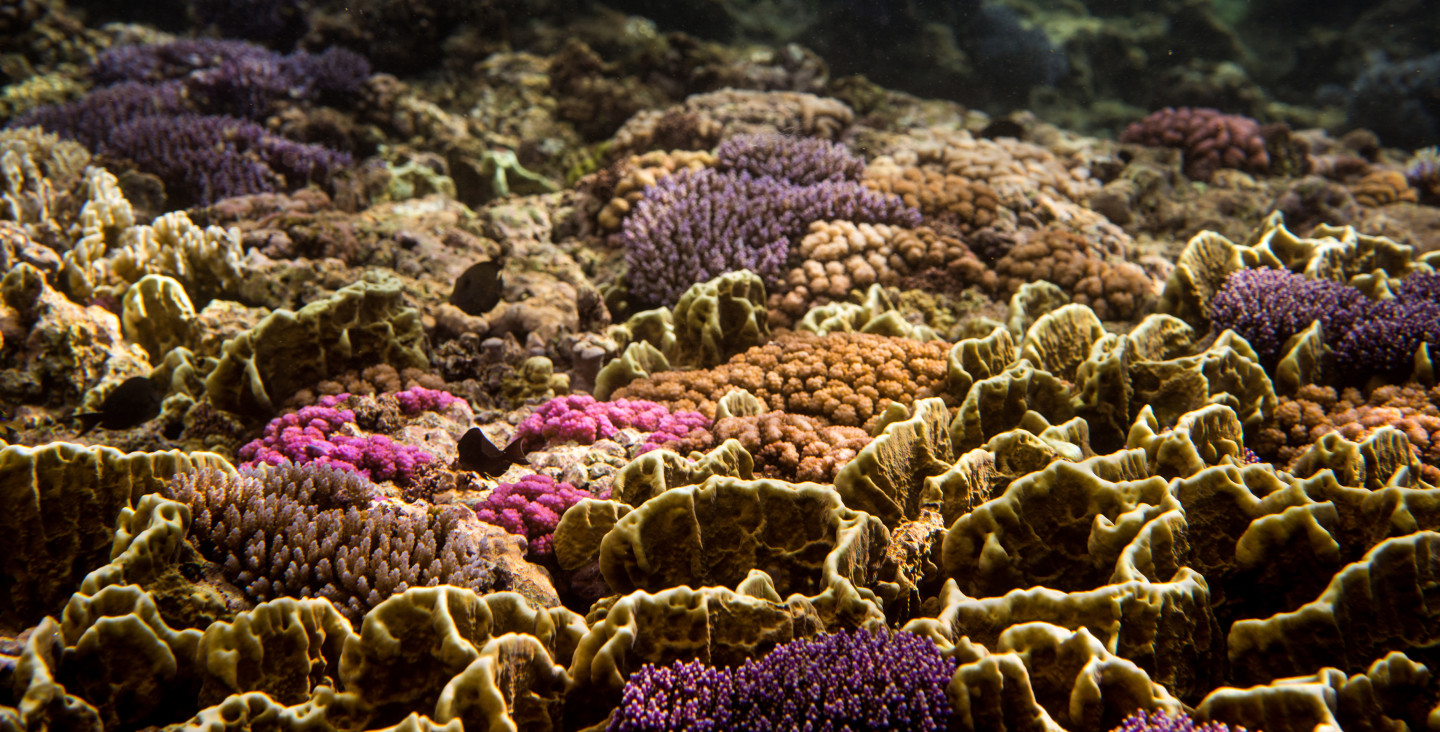Corals build the Reef
Corals form the basis for an entire ecosystem, they build the reef themselves. Many inhabitants of the reef have a close relationship with the corals and with each other, leading the reef to sustain itself as well!
What are corals? Corals are animals. Most tropical corals live in colonies consisting of hundreds to thousands of interconnected polyps. Together they build up a skeleton of calcium carbonate.
With their tentacles, the corals catch plankton and organic material out of the water. But they are not solely reliant on catching prey. Reef-building corals live in symbiosis with unicellular algae. Countless tiny algae within the coral’s cells convert solar energy into food for their hosts through photosynthesis. Thanks to this extra energy, the corals can build the massive calcareous structures that make up a coral reef.

Coral reefs are an incredible source of biodiversity! According to current research, around 1500 species of stony corals are known. In addition, reefs are home to diverse creatures - almost a third of all marine species can be found in coral reefs, that's more than a million!
Depending on the species, corals grow in a wide variety of shapes and thereby offer the reef inhabitants many niches to hide in and find food. The reef substructure, consisting of the limestone skeletons below the living coral polyps, is called the reef framework. It is riddled with channels and cavities in which an efficient recycling of nutrients takes place.
The corals thus form the basis for an entire ecosystem, the reef itself.
Why we care for coral reefs: their importance for humankind
Us humans like settling at the coasts while the goods and other services provided by our oceans secure the livelihoods of many. In tropical countries, for example, the mode of life of coastal populations is often closely linked to the coral reef and 500 millions of people directly or indirectly depend on healthy reefs. Fishing and tourism are important sources of income for local populations, especially in countries where there are few alternatives for earning a living. The reefs are the nursery of numerous fish species, including many that are caught in order to be sold elsewhere and not just enjoyed locally. Every year coral reefs attract millions of tourists - many enjoy the reefs’ beauty by snorkeling or diving. In addition, coral reefs absorb over 90% of the wave energy coasts are exposed to. They are thus a natural, self-sustaining coastal protection against frequent tropical storms and hurricanes. The great biodiversity of coral reefs - like that of tropical rainforests (link Amazonas blog 1) - is an important source of new medical remedies.
In total, coral reefs cover only an area of almost 300,000 km², but “healthy and intact coral reefs provide critical ecosystem services that amount to an equivalent of nearly US$10 trillion per year” (Rebuilding Coral Reefs - A Decadal Challenge).
A coral reef thrives with diversity
Corals have been successfully surviving on our planet for many millions of years and there are various groups of corals, including soft corals, sea fens and stony corals, the latter build the reef with their skeletons. According to current research, there are 1500 species of stony corals. In addition, the reefs are home to many creatures - it takes entire books to describe their diversity. Although reefs only make up a very small portion of the sea floor, they contain almost a third of all described marine species - up to a million! The greatest diversity of coral species and their inhabitants can be found in the so-called Coral Triangle, which covers an area from the Philippines to Malaysia to Indonesia (west to the Solomon Islands). With over 500 coral species, it is home to the world's greatest diversity of reef species!
Why genetic diversity is key
Corals, like every living being, need genetic diversity: organisms can adapt to environmental changes through evolutionary processes, sometimes surprisingly quick. Genetic diversity is the prerequisite for achieving this. Every time a population of organisms reproduces sexually, new genotypes are created through recombination - the genetic cards are being reshuffled, so to speak. The more genetic diversity there is, the greater the chances that there will be offspring that can cope better with the prevailing conditions than their parent generation. It is therefore important to maintain as much genetic diversity as possible in the remaining coral populations.
What makes up a coral reef?
Charles Darwin was already fascinated by coral reefs (Darwin’s Paradox): How can such a productive ecosystem with its immense biodiversity thrive in an apparently very nutrient-poor environment? Today, this mystery has been solved, at least rudimentary. The close connection between its organisms and the resulting effective transfer and recycling of material and nutrients ensure the diversity of life on the reef.
This also means that the corals cannot build and maintain the reefs entirely on their own. In addition to receiving support from their algal symbionts with reef building, crustose coralline algae (CCA) cement the lower part of the coral skeleton that is no longer covered by living tissue - the reef framework. They are the "putty" that firmly holds everything together. This substructure of the reef is riddled with channels and cavities. Organisms such as sponges grow in those channel systems, filtering the water and releasing nutrients: an effective recycling within the reef. Algae-eating fish and other "grazers" keep competition from algae to a minimum. Many of the reef’s inhabitants have a close relationship with corals and each other. The coral reef ecosystem not only builds itself, but also sustains itself. For many millions of years so far.
Where can you find coral reefs?
Tropical coral reefs grow in the light-flooded shallow waters between the 30th parallel north and south - within the coral belt along the equator. The two large reef regions are being distinguished according to their species composition: in the Atlantic and in the Indo-Pacific. The reefs of the Atlantic are mainly located in the Caribbean, a relatively confined area with its own species and great human influence. The majority of reefs are found in the Indo-Pacific, the most famous one is probably the Australian Great Barrier Reef. It stretches across 1,800 miles along the coast of Australia and can even be seen from space. Between the Indian Ocean and the North Pacific is not only the species-rich Coral Triangle, but also a variety of reefs - including some of the most pristine our planet has to offer. You can also find reefs in the Red Sea which are particularly resilient due to the natural fluctuations in water temperature and are therefore exciting for coral researchers to study. Actually, the Great Barrier Reef in Australia is the largest structure ever built by living creatures on this planet and it’s quite young for a reef: only 500,000 years old, and the now living portion only began growing after the last ice age.
This text was written by Heinz Krimmer and Dr. Carin Jantzen as part of a joint project with Patagonia Marina, Dr. Vreni Häussermann and Günther Förterra, to raise public awareness of the global climate crisis and its impact on coral reefs. Its first part was originally published here.

